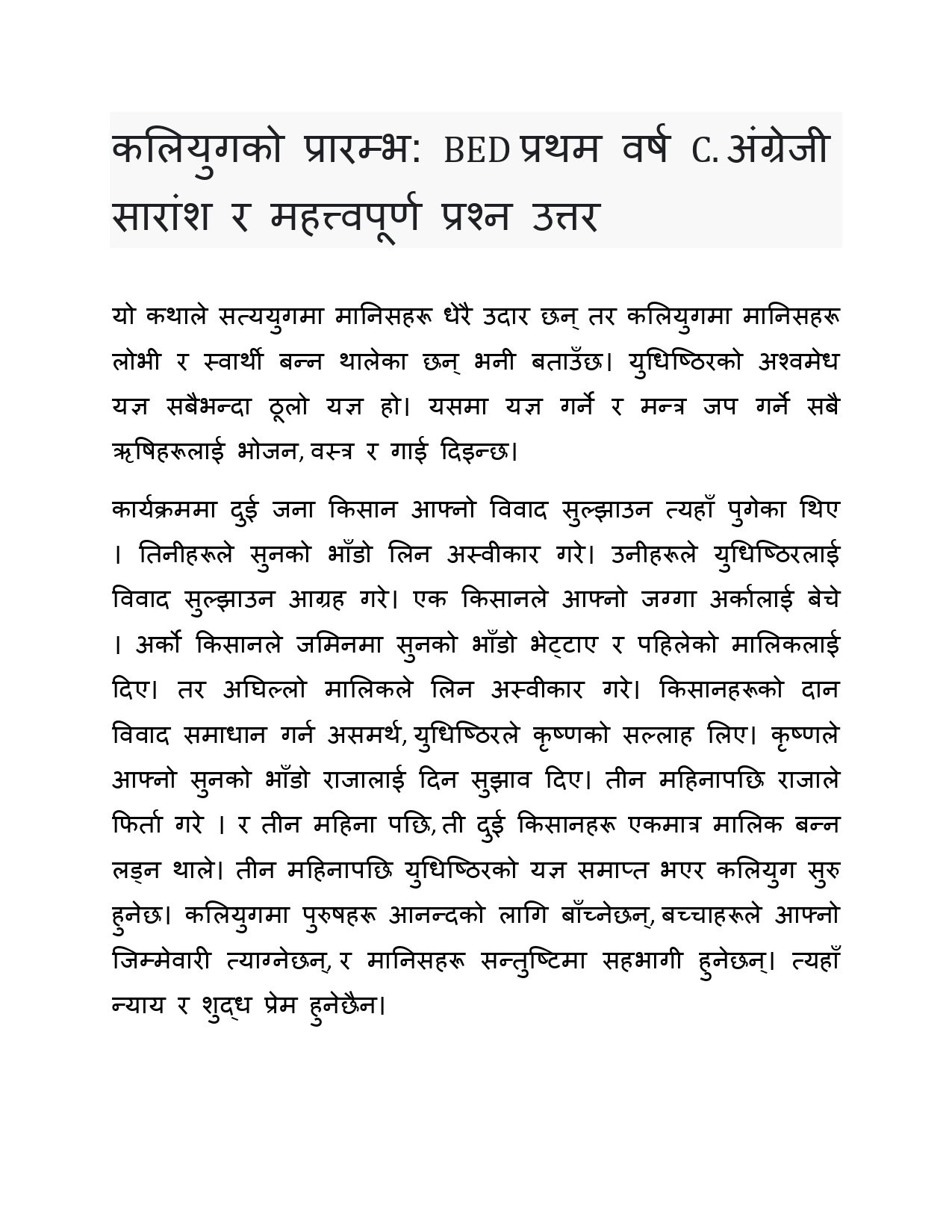Start of Kaliyuga: Bed First Year C.English
Summary and Important Question Answer
Summary in English and Nepali
This story tells us that people in Satya Yuga are very generous but people started to become greedy and selfish in Kali Yuga. Yudhishtira’s Ashwamedha Yagna is the greatest Yagna. In it, all Rishis who perform Yagna and chant Mantras are given food, clothes, and cows.
During the ceremony, two farmers came there to resolve their dispute. They refused to take the pot of gold. They begged Yudhishtira to settle the dispute. One of the farmers sold his land to the other.
The other farmer found the pot of gold in the land and gave it to the former owner. But the previous owner refused to take it. Unable to resolve the farmers’ charity dispute, Yudhishtira took Krishna’s advice. Krishna suggested giving their pot of gold to the king. The king returned it after three months.
And after three months, those two farmers started to fight to become sole owners. Three months later, the Yagna of Yudhishtira will end and the Kali-yuga will begin. In Kaliyuga, men will live for pleasure, children will give up their responsibilities, and people will participate in contentment. There will be no justice and pure love.

When all the rituals are over after three months, a mongoose jumps into the hearth, rubs its regular face over the remains of the charred ritual, and then leaves the altar with a disappointed look on its face.
He complained that in an earlier ritual, half of his body had turned to gold after rubbing, but this ritual did not turn the rest of his body into the gold he hoped would. can be changed. He said that he had previously rubbed his body on the leaves on which food was offered to guests by a starving poor family.
The Rishis realized that Yudhishtira’s sacrifice was not for charity but for royal power. Therefore, it is less of a ritual. Therefore, when Kaliyuga is defeated, Pandav will change their behavior. Arjun will submit to vanity, gluttonous Bhim, amused Nakul, and arrogant Shahadeva. Only Yudhishtira will cling to her responsibilities.

Answer the question
a) What is the significance of the story of the two farmers?
Ans: The moral of the story is that the former Kaliyuga were honest, charitable, and generous. They don’t have greed. They are full of compassion and generosity. But with the arrival of Kaliyuga, people started to become greedy and arrogant.
b) What does the story of Con Cuong suggest?
Ans: Mongoose’s story suggests that charity is the most important ritual. The poor family gives food to the guests and saves them. Therefore, it is more philanthropic. But Yudhishtira’s sacrifice was related to royal power. This is why the body of the half-mongoose does not turn to gold during the Yudhishtira ritual as it does on the leaves that poor families use to treat their guests.
c) According to Krishna, what will happen in Kaliyuga? Provide details.
Ans: Kaliyuga is a new era. Nothing will be the same in it. Men will love materialistic activities like pleasure and sex like animals. Power will be respected in it.
Detail Summary of “The Start of Kali Yuga”
“The Start of Kali Yuga” is written by Devdutt Pattanaik, an Indian author and mythologist. The book explores the concept of Kali Yuga, considered the last of the four ages or Yugas in Hindu mythology.
In Hindu cosmology, Kali Yuga is considered the age of darkness, chaos, and moral decay. It is believed that this is the time when people lose their spiritual connection and are dominated by greed, selfishness, and materialism. The book delves into various myths, legends, and scriptures discussing the characteristics and meanings of Kali Yuga. Pattanaik explores the idea that Kali Yuga is not only a time of decline but also an opportunity for personal growth and spiritual transformation. It delves into the various myths and stories associated with this era, highlighting the lessons they offer and the wisdom they impart.
Through his analysis, Pattanaik aims to provide a deeper understanding of Kali Yuga and its relevance in today’s world. It explores how features of this era manifest in contemporary society and provides insight into how individuals can overcome challenges and find meaning and purpose amid the chaos.
“The Start of Kali Yuga” is a thought-provoking book that combines mythology, philosophy, and spirituality to shed light on the meaning of Kali Yuga and its impact on human existence. It invites readers to reflect on their own lives and the choices they make, encouraging them to find their path to spiritual growth and enlightenment.
“The Start of Kali Yuga” by Devdutt Pattanaik is a book that explores the concept of Kali Yuga, the last of the four ages in Hindu mythology. The book delves into the characteristics and meanings of this period, which is considered a period of darkness, moral decay, and spiritual disconnection. Pattanaik examines the many myths, legends, and scriptures associated with Kali Yuga, giving insight into its relevance in today’s world. It highlights the lessons and wisdom that can be learned from these stories and explores how individuals can overcome the challenges of this age to find personal growth and spiritual transformation. sacred. The book encourages readers to reflect on their own lives and choices, inviting them to find meaning and purpose amid the chaos of Kali Yuga.

